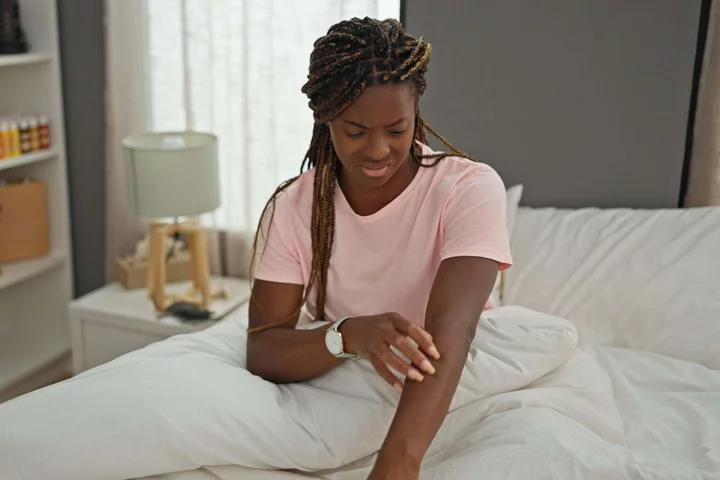
Scientist discovers oldest water on Earth and drinks it
A scientist who found the oldest water ever discovered on Earth decided the best course of action was, of course, to drink it. Professor Barbara Sherwood Lollar was leading a team of geologists studying a Canadian mine in 2016 when she made the remarkable discovery. The flowing water about three kilometres below the surface was between 1.5bn and 2.6bn years old, according to tests, making it the oldest water found on Earth. “When people think about this water they assume it must be some tiny amount of water trapped within the rock,” said Prof Sherwood Lollar. “But in fact it’s very much bubbling right up out at you. These things are flowing at rates of litres per minute – the volume of the water is much larger than anyone anticipated.” Upon tasting the ancient water, she found that it was “very salty and bitter” and “much saltier than seawater”. That was an encouraging sign, because saltier water tends to be older. In this case, where the water has been ageing for billions of years, it is hardly surprising. “If you’re a geologist who works with rocks, you’ve probably licked a lot of rocks,” said Sherwood Lollar. Her team also found that life had once been present in the water, by looking at the sulphate – the composition of salts – in it. “We were able to indicate that the signal we are seeing in the fluids has to have been produced by microbiology – and most importantly has to have been produced over a very long time scale. “The microbes that produced this signature couldn’t have done it overnight. “This has to be an indication that organisms have been present in these fluids on a geological timescale.” Fortunately, the scientist had no terrifying sci-fi movie-esq reaction to drinking the ancient water, and lived to tell the tale. The paper was published in Nature in 2016. How to join the indy100's free WhatsApp channel Sign up to our free Indy100 weekly newsletter Have your say in our news democracy. Click the upvote icon at the top of the page to help raise this article through the indy100 rankings.
2023-10-27 00:29

The Whiteboard: Shai Gilgeous-Alexander made an MVP statement
Today on The Whiteboard, Shai Gilgeous-Alexander makes an MVP statement, James Harden is back, big performances from last night and more.
2023-10-27 00:28

Barry Sanders Having Some Trouble on LinkedIn
Barry Sanders can't get on LinkedIn.
2023-10-26 22:19

UN agencies reduce Gaza aid operations as fuel runs out
The UN says it has enough to maintain water supplies for a day, after reducing support for hospitals.
2023-10-26 22:18

Scientists have discovered a ghost-white shark with a rare condition
Scientists have discovered a ghost-white shark with a rare condition. The predator was accidentally hooked by fishermen dedicated to catching sole. They were working from the coastal area of Los Chimus in Peru and informed authorities of the find. At the time of its capture, the shark had injuries to its gill slits as a result of being caught up in the net last month. The marine animal was transferred to the Peruvian Institute of the Sea (IMARPE) in Chimbote to undergo tests. Scientists discovered that the shark had leucism, which causes partial loss of pigmentation. The condition differs to albinism, which is a complete lack of melanin - a substance in the body that produces hair, eye and skin pigmentation. Albinos often have pink or red eyes but while leucism often makes an animal’s skin white, it does not affect their eye colour. IMARPE said this is the first known case of a shark in Peruvian waters having this condition. The fish was a young female that measured 89cm in length. Sexual maturity in females takes place when they are around 220cm in length. The predatory species sits high on the trophic food chain and mostly feeds on other sharks, rays, cetaceans and sea lions. Broadnose sevengill sharks are known to hunt in packs to bring down large prey. They are recognisable by their seven gill slits as most shark species have five. Sign up for our free Indy100 weekly newsletter How to join the indy100's free WhatsApp channel Have your say in our news democracy. Click the upvote icon at the top of the page to help raise this article through the indy100 rankings
2023-10-26 21:21

Assessing Israel's overnight raid of the Gaza Strip
Israel's manoeuvre has been described as "a tactical operation", meaning it was limited in scope.
2023-10-26 20:57

KFC shuts Lesotho stores over South Africa bird flu
Lesotho has banned poultry imports from South Africa, leaving the fast food chain short of chicken.
2023-10-26 20:56

How delay to Israel offensive benefits US
Washington hopes to use a delay in Israel's incursion into Gaza to shore up protection for its interests.
2023-10-26 20:20

TikTok influencers warn about ‘potent’ steroid cream risks among black women – dermatologist explains the risks
According to skin influencers on TikTok, topical steroid creams are being ‘illegally sold’ in some black Afro hair and beauty supply stores, affecting black women in particular. Angela Mavalla, a pharmacist and skincare educator, has been sharing TikTok videos garnering thousands of views, encouraging black women to stop purchasing topical steroid creams from these shops – as they are meant to be prescription-only treatments used with appropriate guidance from a doctor. When used incorrectly, the creams can make potentially make skin symptoms worse and harder to manage. “Though these creams tend to address issues like acne and eczema very quickly, because of their potent nature, the skin becomes addicted to it and will flare up badly once you stop using them,” said Mavalla. “A lot my clients – [who are black women] – that I consult privately, were coming to me with issues relating to topical steroid use, such as having terrible flare-ups because they had stopped using the cream, and needed help with tapering off them. “I began making content based on these creams, mainly to warn people of them, and found that these TikTok’s would go viral in a short space of time, with lots of people relating to it, and giving their own testimonials of how the creams damaged their skin,” Mavalla added. “I have seen instances of accidental skin bleaching, worsened eczema and hyperpigmentation, topical steroidal withdrawal and addiction, and worst of all, a crippling low self-esteem and self image. It’s awful. “The first point of call when it comes to steroidal creams should always be a pharmacy. Pharmacists are always willing to help, advise and where necessary, signpost to the most appropriate medical profession, such as a dermatologist.” Dr Unnati Desai, the national GP lead, as well as safeguarding lead for GP services and dermatology lead at Nuffield Health, acknowledged that it can take sometimes take time to correctly diagnose these conditions, and might require a biopsy. It might also take a longer period of time to get symptoms under control, as skin conditions may require trying multiple different treatment regimes to find the one that suits each individual person, as well as getting to grips with individual triggers. What are topical steroid creams and what should they be used for? Doctors prescribe topical steroid creams to treat a wide range of skin complaints – but it’s important to have proper assessments first. “They are topical medications (synthetic corticosteroids) that have an anti-inflammatory action on the skin, by suppressing the skin immune system and constricting the blood vessels of the skin where applied,” Desai told the PA news agency. “They are used for dermatological conditions that result in inflamed, itchy or irritated skin – e.g. eczema, psoriasis, lichen simplex, lichen planus, lichen sclerosus and other autoimmune dermatoses.” Why do people experience topical steroid withdrawal after using steroid creams? When used incorrectly, topical steroids may have potentially significant side-effects. And as Desai warned: “Stopping any steroid treatment suddenly can often result in a flare-up of the condition, which may be worse than the original presentation.” There are some obvious signs and symptoms to look out for to figure out if you are experiencing topical steroid withdrawal, such as red, burning skin and a lumpy, papulopustular rash. “When using a steroid cream to get a dermatitis flare-up under control, especially when a more potent steroid cream has been used for a prolonged period of time, it is necessary to slowly come off the steroid cream and wean your skin off treatment by either reducing the potency of the cream, or the frequency [of application],” said Desai. “This gives the skin time to adjust to coming off the steroid cream slowly, but also clarifies whether the skin condition is coming under control with treatment. “Sometimes, severe dermatoses require long-term use of a medication to be controlled, in which case your doctor will consider alternative treatment modalities.” What damage can it do to your skin?Desai added: “Long-term use of potent steroid creams is not recommended, as there may be some systemic absorption, which can result in suppression of your body’s natural cortisol hormone at the worst. “In most cases, it is the long-term impact on the skin itself that is the concern, as regular or long-term use of steroid creams can impact the skin integrity and thickness, resulting in thinning of the skin, stretch marks, increased hair at the site of use, enlarged skin blood vessels and bruising. “Using a steroid cream when there is an underlying infection present on the skin will make the infection worse, or using steroid creams on the face can result in other chronic skin conditions, such as perioral dermatitis or other acneiform eruptions. “Occasionally, an allergy can develop to components within the cream that can make the dermatitis worse.” How can people remain safe? Desai stressed the importance of only using topical steroid treatments under the appropriate supervision of a qualified clinician. “In addition, as most chronic inflammatory skin conditions tend to result in drier skin, self-care at home with soap substitutes and emollients is important,” she said. “This includes gently cleansing the skin one to two times daily maximum (over-washing will negatively impact the skin barrier function, as will long hot bubble baths), and using unscented emollients (medical grade skin creams designed to gently hydrate the skin), which will better protect the skin and may, depending on the skin condition, make a flare-up less frequent or less severe. “If a steroid cream is needed, a doctor will recommend the amount of cream to be used according to the size of the area affected. We use the ‘Finger Tip Unit’ (FTU) – one FTU is the amount of topical steroid that is squeezed out from a standard tube along an adult’s fingertip – as a method of advising each patient how much cream they need to use with each application.” Read More House of the Year 2023 shortlist revealed by Royal Institute of British Architects Fatima Whitbread supporting new fostering campaign, as research finds ‘misconceptions put people off’ 5 key coat trends to complete your autumn/winter wardrobe 12 ways to weave some woodland wonder into your home Hibernation mode: 5 small self-care adjustments to make before the clocks change 13 possible cancer symptoms you should get checked out
2023-10-26 19:50

Ukraine war: Russians likely targeted Khmelnytsky nuclear plant - Zelensky
The International Atomic Energy Agency said the plant's operations were unaffected.
2023-10-26 18:58

Daniel O'Donnell: My music is 'not everyone's cup of tea'
After 40 years in the business, Daniel O'Donnell has fans in high places and a dollop of modesty.
2023-10-26 18:15

Aberdeen mother and young son die in Mumbai fire
Dr Glory Valthaty was understood to have been visiting relatives with her two children and husband.
2023-10-26 17:51
